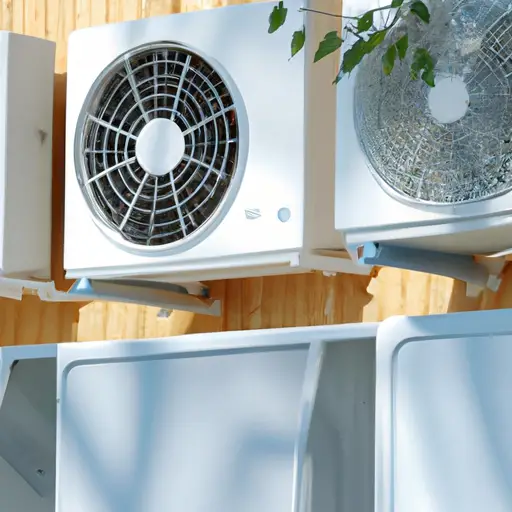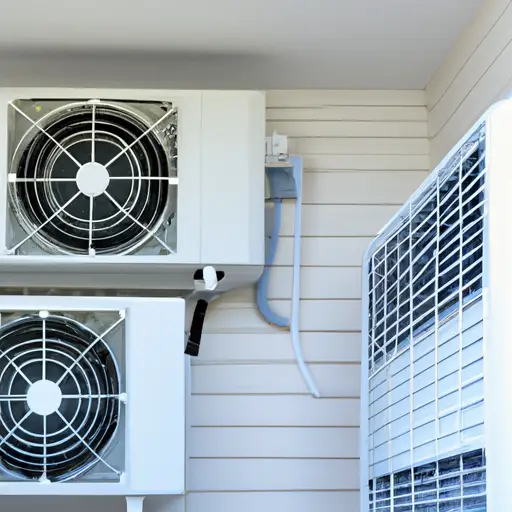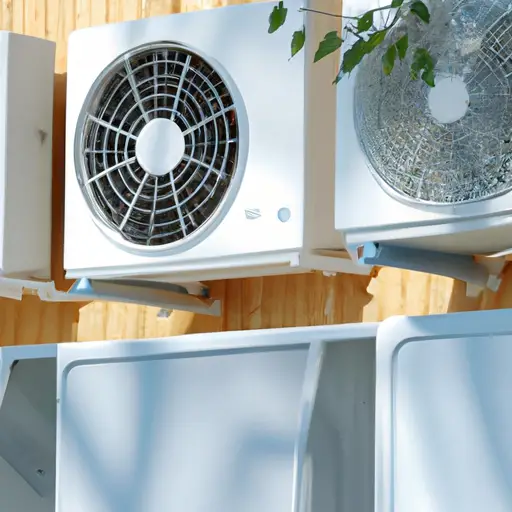Do you ever think about living off the grid? I mean, imagine being completely self-sufficient and independent, not relying on public utilities for your energy needs. It sounds pretty amazing, right? Well, one of the key components of off grid living is finding alternative solutions for heating your home. And that’s exactly what we’re going to talk about today – alternatives to heat pumps.
Now, heat pumps are great and all, but they do have their limitations. They require electricity to operate, which doesn’t really align with the whole off grid lifestyle. So, what options do you have? Well, fear not, because there are actually quite a few alternatives to heat pumps that you can consider. From wood-burning stoves to solar heaters, there are plenty of options out there to keep you warm and cozy in your off grid paradise.
In this article, we’ll dive into the details of each alternative to heat pumps, exploring their pros and cons, costs, and sustainability. We’ll also discuss how they work and what factors you should consider when choosing the right heating solution for your off grid home. Whether you’re interested in harnessing the power of the sun or going old school with a traditional fireplace, we’ve got you covered. So, keep reading and get ready to discover the world of alternatives to heat pumps. You’ll be surprised at just how many options are available to you!

Introduction
What is the purpose of a heat pump?
A heat pump is a device that is commonly used for heating and cooling homes and buildings. It works by transferring heat from one location to another, using a refrigeration cycle. The purpose of a heat pump is to provide a reliable and efficient source of heating and cooling, helping to maintain a comfortable indoor environment throughout the year.
Why are alternatives to heat pumps important?
While heat pumps are widely used and have many advantages, there are situations where alternative heating systems may be more suitable or desirable. This could be due to factors such as the availability of resources, environmental concerns, or specific heating requirements. Exploring alternatives to heat pumps is important to ensure that homeowners have a range of options to choose from that best meet their needs and preferences.
Solar Heating Systems
Overview of solar heating systems
Solar heating systems utilize the sun’s energy to provide heat for residential and commercial buildings. These systems typically consist of solar collectors that absorb sunlight, a heat transfer fluid, and a storage tank. Solar heating systems can be used for space heating, domestic hot water, and even pool heating.
How do solar heating systems work?
Solar heating systems work by collecting sunlight and converting it into thermal energy. The solar collectors, usually mounted on a roof or a ground-mounted structure, absorb the sun’s radiation. The heat transfer fluid, such as water or a special anti-freeze solution, flows through the collectors, which transfers the heat from the collectors to the storage tank. The stored heat can then be used to provide hot water or distributed through a radiant heating system.
Advantages and disadvantages of solar heating systems
One of the main advantages of solar heating systems is their renewable and clean source of energy. By harnessing the power of the sun, they can significantly reduce greenhouse gas emissions and reliance on fossil fuels. Additionally, solar heating systems can provide long-term cost savings by reducing utility bills. However, they do have some limitations. They require adequate sunlight for optimal performance, and the initial investment cost can be higher compared to traditional heating systems. Maintenance and backup systems may also be needed in case of prolonged periods of low sunlight or high demand.
Geothermal Heating
What is geothermal heating?
Geothermal heating is a heating system that utilizes the natural heat of the earth to provide warmth for residential and commercial buildings. It harnesses the constant temperature of the earth below the surface, where the temperature remains relatively stable throughout the year.
How does geothermal heating work?
Geothermal heating systems use a series of underground pipes, known as geothermal loops, that circulate a heat transfer fluid. These loops are installed either horizontally or vertically, depending on the available space and soil conditions. During the winter, the system extracts heat from the ground and transfers it to the heat pump, which then distributes the heat throughout the building. In the summer, the process is reversed, and the system can provide cooling by removing heat from the building and transferring it back into the ground.
Pros and cons of geothermal heating
Geothermal heating systems offer several advantages, including high energy efficiency, low operating costs, and environmental friendliness. They are also known for their longevity and reliability. However, the installation cost of geothermal systems can be higher compared to other heating systems, primarily due to the excavation and installation of the geothermal loops. The availability of suitable land or space can also be a limitation, as well as the need for professional installation and maintenance.

Biomass Heating Systems
Understanding biomass heating systems
Biomass heating systems utilize organic materials, such as wood pellets, agricultural waste, or dedicated energy crops, to generate heat. These materials, known as biomass fuels, are burned to produce heat, which can then be used for space heating, hot water, or even powering steam turbines to generate electricity.
Different types of biomass fuels
There are various types of biomass fuels that can be used in heating systems, including wood pellets, wood chips, straw, and crop residues. Each type of biomass fuel has its own characteristics in terms of energy content, combustion efficiency, and availability.
Benefits and challenges of biomass heating systems
One of the main benefits of biomass heating systems is their renewable nature. Biomass fuels can be sustainably sourced, reducing the reliance on fossil fuels and minimizing greenhouse gas emissions. Biomass heating systems also provide a high level of efficiency and can be cost-effective, especially in areas with abundant biomass resources. However, biomass heating systems require proper storage and handling of the biomass fuel, regular maintenance, and may produce emissions that need to be properly managed.
Hydrogen Fuel Cells
Overview of hydrogen fuel cells
Hydrogen fuel cells are an alternative heating option that utilizes the chemical reaction between hydrogen and oxygen to produce heat and electricity. These fuel cells can be used to generate heat for residential and commercial buildings, offering a potential clean and efficient source of energy.
How do hydrogen fuel cells generate heat?
Hydrogen fuel cells generate heat through an electrochemical process. Hydrogen gas is supplied to one side of the fuel cell, while oxygen from the air is supplied to the other side. The hydrogen gas is split into protons and electrons, and the protons migrate through a membrane, while the electrons flow through an external circuit, creating an electric current. The flow of protons and electrons recombine with oxygen on the other side of the fuel cell, creating heat and water vapor as byproducts.
Advantages and limitations of hydrogen fuel cells for heating
Hydrogen fuel cells offer several advantages, including high efficiency, low emissions, and a potentially unlimited supply of hydrogen. They can operate silently and have a long lifespan with minimal maintenance requirements. However, there are still limitations to widespread adoption, such as the availability and infrastructure for hydrogen production and distribution. The cost of hydrogen fuel cells can also be a barrier, although advancements in technology and economies of scale may help reduce costs in the future.
Electric Resistance Heating
What is electric resistance heating?
Electric resistance heating is a heating system that converts electrical energy into heat. It is commonly used in portable heaters, electric baseboard heaters, and electric furnaces.
Types of electric resistance heating systems
There are several types of electric resistance heating systems, including radiant heaters, electric furnaces, and electric baseboard heaters. Radiant heaters use infrared radiation to directly heat objects and people in a room. Electric furnaces use heating elements and blowers to distribute warm air throughout a building. Electric baseboard heaters are installed along the baseboard of a room and use convection to heat the air.
Pros and cons of electric resistance heating
Electric resistance heating offers simplicity, affordability, and ease of installation, as it does not require the use of any fuel or combustion processes. It is also highly responsive, providing instant heat when needed. However, electric resistance heating can be costly to operate, especially in areas with high electricity rates. It is also less energy-efficient compared to other heating systems, as a significant amount of energy is lost during the conversion from electrical energy to heat.
District Heating Systems
Introduction to district heating
District heating systems provide heat to multiple buildings or a whole neighborhood from a centralized location. They are commonly used in urban areas to efficiently distribute heat from a heat source to surrounding buildings.
How do district heating systems work?
In a district heating system, heat is generated at a central plant using various sources, such as natural gas, biomass, or waste heat from industrial processes. The heat is then transported through a network of underground pipes to individual buildings, where it is used for space heating and hot water. District heating systems can also be integrated with cooling systems to provide both heating and cooling services.
Advantages and challenges of district heating
District heating systems offer several advantages, including higher energy efficiency, reduced environmental impact, and the potential for utilizing waste heat from industrial processes. They eliminate the need for individual boilers in each building, reducing maintenance and investment costs for building owners. However, the implementation of district heating systems can be complex and require extensive planning and infrastructure development. Technical challenges, such as heat loss during distribution and energy demand matching, need to be carefully addressed for optimal system performance.
Radiant Heating Systems
Understanding radiant heating
Radiant heating systems use radiant heat transfer to warm a space. This is achieved by heating a surface, such as a floor, wall, or ceiling, which then radiates heat to surrounding objects and people.
Types of radiant heating systems
There are several types of radiant heating systems, including hydronic systems and electric systems. Hydronic systems circulate hot water through a network of pipes installed in the floor, walls, or ceiling. Electric systems use heating cables or electrical mats to generate heat directly on the surface.
Benefits and considerations of radiant heating
Radiant heating systems offer several benefits, including energy efficiency, improved comfort, and reduced dust circulation compared to forced-air systems. They provide even heat distribution and can be controlled in individual zones, allowing for personalized comfort settings. However, the installation cost of radiant heating systems can be higher compared to traditional heating systems, and they may have longer response times, requiring preheating to achieve desired temperatures.
Wood Stoves and Fireplaces
Traditional heating methods using wood
Wood stoves and fireplaces have been used for centuries as a traditional method of heating. They burn wood logs or pellets to provide heat and ambiance to a space.
Different types of wood stoves and fireplaces
There are various types of wood stoves and fireplaces available, including free-standing wood stoves, fireplace inserts, and masonry fireplaces. Free-standing wood stoves are freestanding units that can be placed anywhere in a room, while fireplace inserts are designed to be installed within an existing fireplace. Masonry fireplaces are built with bricks or stones and can be customized to suit the aesthetics of the space.
Advantages and disadvantages of wood heating
Wood stoves and fireplaces offer a renewable source of heat, as wood is a readily available and sustainable resource. They can provide a cozy and inviting atmosphere and can be an effective backup heating option during power outages. However, wood heating requires proper maintenance, including regular cleaning and ash removal. It also produces emissions, such as smoke and particulate matter, which can be a concern for air quality and may require compliance with local regulations.
Conclusion
Summary of alternative options to heat pumps
Exploring alternatives to heat pumps provides homeowners with a range of options to consider when choosing a heating system. Solar heating systems, geothermal heating, biomass heating systems, hydrogen fuel cells, electric resistance heating, district heating systems, radiant heating systems, and wood stoves and fireplaces all offer unique advantages and considerations.
Choosing the right heating system for your needs
When selecting a heating system, it is essential to consider factors such as energy efficiency, environmental impact, availability of resources, installation and maintenance costs, and individual heating requirements. Consulting with professionals in the field can help homeowners make informed decisions and choose the right heating system that best suits their needs, preferences, and the specific characteristics of their home.
Exploring alternatives to heat pumps presents an opportunity to diversify heating options and move towards more sustainable and efficient sources of heat. By considering these alternatives, homeowners can contribute to a greener future while maintaining comfortable and cozy living spaces.




